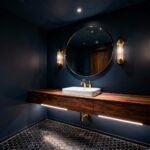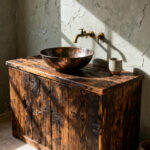Stepping into a living room that perfectly balances beauty with everyday functionality feels like discovering a hidden gem—it’s that moment when you realize a space can be both stunning and genuinely livable. Yet for many homeowners, especially those working with historic properties or challenging layouts, achieving this harmony seems frustratingly elusive. The living room bears the weight of countless daily activities while serving as the primary showcase for your home’s character, creating a complex design puzzle that demands both aesthetic vision and practical wisdom.
The challenge becomes even more pronounced when you’re working within the constraints of older homes, where original architectural details must be preserved while modern comfort is essential. After fourteen years of helping homeowners navigate these exact challenges, I’ve learned that successful living room interiors aren’t born from following rigid design rules, but from understanding how to adapt timeless principles to your unique space and lifestyle.
This comprehensive guide presents 21 battle-tested strategies that address the real-world complexities of creating exceptional living spaces. From respecting architectural heritage while integrating contemporary needs to maximizing functionality without sacrificing character, these insights will help you craft a living room that honors both your home’s history and your family’s future.
1. Define Your Living Room’s Primary Purpose Before Making Any Design Decisions
The foundation of exceptional living room interiors begins with a clear understanding of how the space will actually be used, not how you think it should be used. This critical first step prevents the common mistake of creating a beautiful but impractical room that looks magazine-worthy but fails to support your daily life. In my experience working with historic homes, I’ve seen too many living rooms designed around an idealized vision rather than the reality of family life, resulting in spaces that feel more like museums than homes.

Consider the difference between a family with young children who need durable surfaces and flexible seating arrangements versus empty nesters who prioritize intimate conversation areas and display space for collections. A formal entertaining space requires different traffic patterns and furniture scales than a casual family gathering room. The key is honest assessment: observe how you currently use similar spaces, note where family members naturally congregate, and identify the activities that happen most frequently. This analysis should drive every subsequent decision, from furniture selection to lighting placement.
The craftsmanship reveals itself in details like how well your design decisions support these identified functions, creating a room that feels both intentional and effortlessly comfortable for years to come.
2. Measure Every Dimension Including Doorways and Stairwells
Accurate measurements form the backbone of successful furniture selection and spatial planning, yet this fundamental step is often rushed or incomplete. Beyond basic room dimensions, you must account for the journey furniture will take to reach your living room—measuring doorway widths, stair turns, and ceiling heights along the delivery path. In historic homes, this becomes particularly crucial as doorways and hallways were often built to different standards than modern furniture assumes.

Create a detailed floor plan that includes not just wall-to-wall measurements, but also the locations of outlets, switches, radiators, and architectural features like built-in bookcases or window seats. Note ceiling height variations, especially in older homes where settling may have created subtle changes. Document the swing direction of doors and the height of window sills, as these factors significantly impact furniture placement options.
- Essential measurements to record: Room length, width, and diagonal measurements
- Access route documentation: All doorway widths, stair widths, and turn radiuses
- Architectural features: Window heights, fireplace dimensions, built-in locations
- Utility locations: Electrical outlets, cable connections, heating elements
What makes this choice better for our planet is the prevention of unnecessary returns and the waste associated with furniture that doesn’t fit, reducing both transportation emissions and manufacturing waste from pieces that end up in landfills.
3. Choose a Color Palette That Enhances Your Home’s Architectural Character
Color selection in historic homes requires balancing period authenticity with contemporary livability, creating palettes that honor architectural heritage while supporting modern life. The key lies in understanding your home’s original color story—not to replicate it exactly, but to create a harmonious dialogue between past and present. Research your home’s architectural period to understand typical color relationships, then adapt these principles using today’s improved paint formulations and color technologies.

Consider how natural light interacts with your space throughout the day, as this dramatically affects color perception. North-facing rooms benefit from warm undertones to counteract cool light, while south-facing spaces can handle cooler colors without feeling stark. In rooms with original architectural details like crown molding or wainscoting, use color to either highlight or harmonize these features based on your desired emphasis.
The unexpected pairing that always works is combining historically-inspired neutrals with carefully chosen contemporary accent colors that reflect your personal style while respecting the home’s character.
4. Plan Furniture Arrangements That Respect Both Traffic Flow and Conversation
Effective furniture arrangement in living room interiors requires understanding the natural movement patterns within your space while creating intimate zones for conversation and relaxation. Historic homes often present unique challenges with their formal layouts and architectural features that must be accommodated rather than ignored. The goal is creating clear pathways that feel intuitive while establishing comfortable seating arrangements that encourage interaction.

Begin by identifying primary and secondary traffic routes—the paths people naturally take when entering, moving through, or exiting the space. Maintain at least 36 inches for main walkways and 24 inches for secondary paths. Consider the relationship between your living room and adjacent spaces, ensuring furniture placement doesn’t create bottlenecks or awkward transitions. In older homes, work with existing architectural features like fireplaces or built-in bookcases as natural anchors for seating arrangements.
- Traffic flow essentials: Maintain clear sight lines and unobstructed pathways
- Conversation zones: Position seating within 8-10 feet for comfortable dialogue
- Architectural integration: Use built-in features as natural furniture anchors
- Flexibility considerations: Allow for seasonal furniture adjustments
The visual weight balances perfectly when you consider both the physical mass of furniture pieces and their visual impact, creating arrangements that feel both grounded and graceful.
5. Select a Sofa That Balances Comfort With Your Room’s Architectural Scale
The sofa selection process requires careful consideration of both human comfort and architectural proportion, especially in historic homes where ceiling heights and room proportions may differ significantly from contemporary standards. A sofa that works beautifully in a modern open-plan space might overwhelm a traditional parlor or appear lost in a grand Victorian living room. Understanding your room’s scale and your family’s comfort needs ensures this significant investment serves you well for years.

Evaluate your room’s architectural details when considering sofa style—a sleek contemporary piece might clash with ornate moldings, while an overly traditional sofa could feel stuffy in a renovated historic space. Consider the sofa’s visual weight in relation to other architectural elements, and don’t forget practical factors like fabric durability, cushion construction, and maintenance requirements. In homes with original hardwood floors, consider the sofa’s weight distribution to prevent damage to historic flooring.
“The sofa is the foundation upon which the entire room’s comfort and style rest. Choose wisely, considering both the room’s architectural character and your family’s daily needs.” – This philosophy has guided countless successful living room transformations in historic properties.
The artisan collective that creates these pieces understands the importance of both traditional construction methods and contemporary comfort requirements, resulting in furniture that honors craftsmanship while serving modern life.
6. Integrate Storage Solutions That Preserve Architectural Integrity
Storage in historic living room interiors requires creative solutions that address modern organizational needs while preserving architectural character. The challenge lies in adding functional storage without compromising the room’s original design intent or visual flow. Built-in solutions often work best, as they can be designed to complement existing architectural details while providing necessary functionality for contemporary living.

Consider the room’s existing storage assets—built-in bookcases, window seats with storage, or alcoves that can be fitted with custom solutions. Modern families accumulate more items than historic homes were designed to accommodate, so creative integration becomes essential. Look for opportunities to add storage within existing architectural features rather than imposing new elements that compete with original details.
- Built-in opportunities: Utilize alcoves, under-stair spaces, and window seat areas
- Furniture-integrated storage: Ottomans, coffee tables, and console tables with hidden compartments
- Architectural harmony: Design storage solutions that complement existing millwork and proportions
- Accessibility considerations: Ensure storage solutions work for all family members
The sustainable journey of this material involves selecting storage solutions that will age gracefully with your home, using materials and construction methods that complement rather than compete with original architectural elements.
7. Layer Lighting to Support Both Function and Architectural Features
Lighting in historic homes requires a sophisticated approach that serves modern functional needs while highlighting architectural details that deserve celebration. The layered lighting concept becomes particularly important in older homes where original lighting may have been minimal and room proportions require careful illumination to feel balanced and inviting. Understanding how to blend period-appropriate fixtures with contemporary lighting technology creates spaces that feel both historically authentic and thoroughly modern.

Ambient lighting provides overall illumination, but in historic homes, this layer must work with existing architectural features rather than against them. Consider how ceiling medallions, crown molding, and other decorative elements can be enhanced through strategic lighting placement. Task lighting becomes crucial for reading and other activities, while accent lighting can transform architectural details into focal points that celebrate your home’s character.
The evolution of this trend reflects broader cultural shifts toward appreciating both historical preservation and modern functionality, creating lighting schemes that serve contemporary life while honoring architectural heritage.
8. Choose Area Rugs That Define Spaces While Complementing Architectural Elements
Area rugs in historic homes serve multiple functions beyond mere decoration—they define seating areas, provide acoustic dampening in rooms with hard surfaces, and can bridge the gap between historic architecture and contemporary comfort. The key lies in selecting rugs that complement rather than compete with existing architectural details while creating the intimate scale necessary for comfortable living in rooms that may have been designed for more formal use.

Consider your room’s architectural period when selecting rug patterns and colors. A Persian rug might feel authentic in a Victorian home but overwhelming in a Colonial space, while a contemporary geometric pattern could provide an interesting counterpoint to ornate architectural details. Size is crucial—the rug should be large enough to anchor your seating arrangement while respecting the room’s proportions and architectural features like fireplace hearths or built-in elements.
As morning light filters through, the texture creates subtle shadows that add depth to both the rug and surrounding architectural details, demonstrating how thoughtful selection enhances rather than masks your home’s character.
9. Incorporate Textures and Patterns That Enhance Rather Than Overwhelm Historic Details
Texture and pattern selection in historic living room interiors requires a delicate balance between adding visual interest and respecting existing architectural richness. Rooms with elaborate crown molding, detailed wainscoting, or ornate fireplace surrounds already possess significant visual complexity, so additional patterns must be chosen carefully to enhance rather than compete. The goal is creating layers of interest that feel harmonious rather than chaotic.

Understanding your room’s existing pattern vocabulary helps guide new additions. If your space features geometric architectural details, organic patterns in textiles can provide pleasing contrast. Conversely, if architectural elements are primarily curved or flowing, geometric patterns in fabrics might add beneficial structure. Consider scale relationships—small patterns can get lost in grand rooms, while large patterns might overwhelm intimate spaces.
- Pattern mixing principles: Vary scales and combine geometric with organic forms
- Texture layering strategies: Mix smooth and rough, matte and glossy surfaces
- Architectural consideration: Let existing details guide pattern and texture choices
- Color coordination: Ensure patterns work within your established color palette
The heritage technique gets a contemporary update through modern textile manufacturing that can recreate historic patterns with improved durability and easier maintenance, allowing you to honor your home’s period while enjoying contemporary practicality.
10. Curate Art and Accessories That Tell Your Story Within Historic Context
Art curation in historic homes presents unique opportunities to create dialogue between past and present, allowing personal expression while respecting architectural context. The key lies in understanding how to display contemporary pieces or family collections in ways that complement rather than clash with period architecture. This approach creates living spaces that feel both historically grounded and personally meaningful.

Consider the scale and proportion of your architectural features when selecting and hanging art. High ceilings and elaborate moldings can handle larger pieces or gallery wall arrangements, while more intimate spaces might benefit from carefully chosen smaller works. The goal is creating visual conversations between your personal collections and the home’s architectural character, allowing both to shine without competition.
The cultural heritage preserved in each piece includes not only the artwork itself but also the story of how it came to be part of your home’s narrative, creating layers of meaning that enrich daily living.
11. Use Mirrors Strategically to Enhance Light and Architectural Features
Mirrors in historic homes serve dual purposes—they can amplify natural light in spaces that may have limited windows while also reflecting and celebrating architectural details that deserve attention. The strategic placement of mirrors can make period rooms feel more spacious and bright without compromising their historic character. Understanding how to position mirrors to capture and redirect light while showcasing architectural features creates a more dynamic and inviting environment.

Consider placing mirrors to reflect beautiful architectural elements like crown molding, decorative ceilings, or built-in bookcases, effectively doubling their visual impact. In rooms with limited natural light, position mirrors to capture and bounce available light deeper into the space. Antique or period-appropriate mirror frames can enhance the historic feel while serving contemporary functional needs.
The quality becomes evident after years of use when well-placed mirrors continue to enhance both the lighting and architectural appreciation of your living space, proving their value as both functional and aesthetic elements.
12. Integrate Plants That Complement Your Home’s Period and Style
Plant selection in historic living room interiors offers opportunities to soften architectural formality while adding life and color to spaces that might otherwise feel museum-like. The key lies in choosing plants and containers that complement your home’s period character while providing the natural elements that make spaces feel lived-in and welcoming. Understanding which plants work well in the light conditions typical of older homes ensures success with your green additions.

Historic homes often have unique light conditions due to smaller windows or different orientations than contemporary construction. Select plants that thrive in these conditions rather than fighting against them. Consider the scale of your architectural features when choosing plant sizes—a grand Victorian parlor can handle larger specimens, while a Colonial keeping room might benefit from smaller, more intimate plantings.
- Light-appropriate selections: Choose plants suited to your specific light conditions
- Period-compatible containers: Select pots and planters that complement architectural style
- Scale considerations: Match plant sizes to room proportions and architectural features
- Maintenance requirements: Consider the care needs within your lifestyle constraints
The environmental story behind this piece began with understanding how plants can improve indoor air quality while adding the natural elements that make historic homes feel alive and welcoming.
13. Style Coffee Tables for Both Beauty and Historic Home Living
Coffee table styling in historic homes requires balancing aesthetic appeal with the practical needs of daily life while respecting the room’s architectural character. The approach differs from contemporary styling because historic rooms often have more formal proportions and architectural details that influence how accessories should be scaled and arranged. Understanding how to create vignettes that feel both polished and livable ensures your coffee table enhances rather than detracts from the room’s overall appeal.

Consider your room’s architectural formality when selecting coffee table accessories. A grand Victorian parlor might call for more elaborate arrangements, while a Colonial keeping room benefits from simpler, more functional styling. The key is creating groupings that feel intentional without appearing overly precious, allowing for the practical use of the table while maintaining visual appeal.
The finishing touch that elevates the entire look involves understanding how coffee table styling can bridge the gap between your home’s historic character and contemporary living needs, creating a surface that’s both beautiful and genuinely functional.
14. Arrange Pillows and Throws for Comfort Within Architectural Context
Textile arrangement in historic living room interiors requires understanding how to add contemporary comfort while respecting period proportions and architectural details. The challenge lies in creating inviting, comfortable seating arrangements that don’t appear out of scale with the room’s historic character. Successful pillow and throw arrangements can soften formal architectural elements while adding the tactile comfort essential for modern living.

Consider your room’s architectural formality when selecting textile colors, patterns, and textures. Formal architectural details might call for more structured arrangements, while simpler architectural contexts can handle more casual, relaxed styling. The goal is creating comfort that feels appropriate to the space while serving your family’s practical needs for warmth and coziness.
The tactile experience changes the entire room’s energy when textiles are chosen and arranged to complement rather than compete with architectural features, creating spaces that feel both historically appropriate and thoroughly comfortable.
15. Create Focal Points That Work With Existing Architectural Features
Focal point creation in historic homes requires working with rather than against existing architectural elements that were designed to command attention. The challenge lies in creating contemporary focal points that complement rather than compete with features like fireplaces, built-in bookcases, or decorative ceiling elements. Understanding how to enhance existing focal points while adding new ones creates visual hierarchy that feels both intentional and harmonious.

Evaluate your room’s existing architectural focal points before adding new ones. A grand fireplace with elaborate mantelpiece may need enhancement rather than competition, while a room lacking strong architectural features might benefit from a bold art piece or furniture arrangement that creates visual interest. The key is understanding how to work with your home’s inherent character rather than fighting against it.
“Every historic room has a story to tell through its architectural features. The designer’s job is to help that story unfold while adding contemporary chapters that feel like natural extensions of the original narrative.”
The traditional methods used result in focal points that feel both historically grounded and personally meaningful, creating visual anchors that serve both aesthetic and functional purposes.
16. Plan Traffic Flow That Respects Both Function and Architectural Layout
Traffic flow planning in historic homes requires understanding how original room layouts were intended to function while adapting them for contemporary living patterns. Historic homes were often designed with more formal circulation patterns that may not align with modern family life, creating the need for thoughtful adaptation that respects architectural intent while serving practical needs. The goal is creating intuitive movement patterns that feel natural while preserving the dignity of original design.

Consider how your family actually moves through and uses the space compared to how the room was originally intended to function. Historic parlors, for example, were designed for formal receiving of guests rather than casual family gathering, so furniture arrangements may need adjustment to serve contemporary needs while respecting architectural proportions and relationships.
The composition comes together when you understand how to balance respect for original architectural intent with the practical needs of contemporary family life, creating spaces that honor both past and present.
17. Add Personal Elements That Enhance Rather Than Clash With Period Character
Personalization in historic living room interiors requires thoughtful integration of contemporary family life with period architectural character. The challenge lies in displaying personal collections, family photos, and meaningful objects in ways that feel harmonious with the home’s historic context rather than jarring or inappropriate. Understanding how to weave personal narratives into historic settings creates spaces that feel both authentic to the architecture and genuinely lived-in.

Consider the scale and style of your personal items in relation to architectural features. Family photos might work better in antique frames that complement the period, while contemporary art might need strategic placement to create intentional contrast rather than accidental clash. The goal is creating personal expression that feels like a natural evolution of the home’s story rather than an imposed contemporary overlay.
The maker’s journey from apprentice to master influenced how personal items can be integrated into historic settings, understanding that the best personalization feels like it has grown organically within the architectural context.
18. Design for Flexibility While Preserving Architectural Integrity
Flexibility planning in historic homes requires balancing the need for adaptable spaces with respect for architectural features that shouldn’t be compromised. The challenge lies in creating rooms that can evolve with changing family needs while preserving the historic elements that give the home its character and value. Understanding how to build in adaptability without sacrificing architectural integrity ensures your living room can serve your family through various life stages.

Consider which elements of your room are permanent architectural features that should be preserved and which are furnishings that can be adapted or changed as needs evolve. Built-in bookcases, fireplaces, and decorative moldings are permanent features that should guide rather than be subordinated to changing functional needs. Furniture arrangements, lighting, and accessories can provide the flexibility needed for evolving lifestyles.
- Permanent architectural elements: Identify features that should be preserved and celebrated
- Adaptable furnishing strategies: Choose pieces that can be reconfigured as needs change
- Seasonal flexibility: Plan for furniture arrangements that can accommodate different activities
- Future-proofing considerations: Consider how the space might need to evolve over time
Beyond aesthetics, the ecological impact matters because preserving and working with existing architectural features reduces waste while creating spaces that can adapt to changing needs without requiring major renovations.
19. Establish Maintenance Routines That Protect Both Furnishings and Architecture
Maintenance routines in historic homes require understanding how to care for both contemporary furnishings and period architectural features, ensuring both remain in excellent condition for years to come. Historic homes often require more specialized care due to materials and construction methods that differ from contemporary standards. Developing routines that address these unique needs while maintaining comfortable living standards ensures your living room interiors remain beautiful and functional.

Consider the specific maintenance needs of your home’s architectural features alongside your contemporary furnishings. Original hardwood floors, plaster walls, and period millwork may require different care approaches than modern materials. Understanding how to maintain these elements while keeping your living space clean and comfortable requires specialized knowledge and appropriate techniques.
The investment value comes from the exceptional care given to both historic architectural elements and contemporary furnishings, ensuring your living room maintains its beauty and functionality while preserving the home’s historic character and value.
20. Integrate Technology Thoughtfully to Preserve Visual Harmony
Technology integration in historic homes requires careful consideration of how contemporary conveniences can be incorporated without compromising architectural character or visual harmony. The challenge lies in providing modern functionality while maintaining the aesthetic integrity that makes historic homes special. Understanding how to conceal or integrate technology appropriately ensures your living room serves contemporary needs while preserving period appeal.

Consider the visual impact of technology on your room’s architectural character. Large flat-screen televisions, sound systems, and other contemporary devices can easily overwhelm period proportions or clash with historic details. The goal is finding integration solutions that provide functionality without sacrificing the architectural qualities that drew you to a historic home in the first place.
The unexpected environmental benefit comes from choosing technology integration methods that work with rather than against your home’s existing infrastructure, reducing the need for extensive renovations while providing contemporary convenience.
21. Plan Seasonal Updates That Celebrate Both Change and Continuity
Seasonal refreshing in historic living room interiors offers opportunities to celebrate both the changing seasons and the enduring character of your home’s architecture. The approach differs from contemporary seasonal decorating because historic homes have inherent character that should be enhanced rather than overwhelmed by seasonal changes. Understanding how to add seasonal interest while respecting architectural context creates spaces that feel both timely and timeless.

Consider how seasonal changes can highlight different aspects of your room’s architectural character. Autumn might call for richer colors that complement wood tones, while spring refreshes might emphasize the natural light that streams through historic windows. The key is using seasonal updates to create variety and interest while maintaining the fundamental character that makes your historic home special.
The forecast for next season already hints at how thoughtful seasonal updates can keep historic homes feeling fresh and contemporary while honoring their architectural heritage, creating spaces that celebrate both continuity and change.
Conclusion
Creating exceptional living room interiors in historic homes requires a thoughtful balance between honoring architectural heritage and serving contemporary family life. Throughout this guide, we’ve explored how successful design emerges from understanding your home’s inherent character while thoughtfully integrating modern comfort and functionality. The key lies not in choosing between historic authenticity and contemporary livability, but in finding the harmonious integration that serves both.
The most successful historic home renovations I’ve witnessed share a common thread: they respect the architectural narrative while writing new chapters that feel like natural extensions of the original story. Whether it’s selecting furniture that complements period proportions, integrating technology that preserves visual harmony, or creating storage solutions that work with existing architectural features, every decision should honor both past and present.
Your historic home offers a unique opportunity to create living spaces that possess both character and comfort—qualities that are increasingly rare in our contemporary world. By applying these principles thoughtfully and consistently, you’ll create living room interiors that not only serve your family’s daily needs but also preserve and celebrate the architectural heritage that makes your home truly special. The investment in thoughtful design pays dividends not just in daily comfort, but in the lasting value and irreplaceable character that only historic homes can provide.






